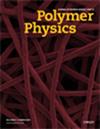采用高速熔融纺丝和纺丝拉伸法制备聚(3 -羟基丁酸酯)可生物降解纤维
3区 工程技术
Q1 Materials Science
Journal of Polymer Science. Part B, Polymer Physics
Pub Date : 2000-11-01
DOI:10.1002/1099-0488(20001101)38:21<2841::AID-POLB130>3.0.CO;2-#
引用次数: 84
摘要
研究了高速熔融纺丝和纺丝拉伸对细菌合成聚3-羟基丁酸酯(PHB)纤维结构和性能的影响。用差示扫描量热法(DSC)和广角x射线散射法(WAXS)对纤维的结晶度、取向和织物物理性能进行了表征。WAXS研究表明,高速和高拉伸比纺丝的纤维具有正交(α改性)和六方(β改性)晶体,后者是应力诱导结晶的结果。在这些过程中形成的纤维结构如原子力显微镜图像所示为原纤维状。类原纤维拉伸后的最大物理断裂应力、模量和断裂伸长率分别为330 MPa、7.7 GPa和37%。低拉伸比4.0得到的纤维具有球状结构,纺织物理性能较差。对PHB球团在干燥、纺丝过程中的降解特性、热性能和流变性能进行了分析。©2000 John Wiley & Sons, Inc[J]生物质化学工程学报,2009,31 (2):444 - 444本文章由计算机程序翻译,如有差异,请以英文原文为准。
Biodegradable fibers of poly(3‐hydroxybutyrate) produced by high‐speed melt spinning and spin drawing
The effects of high-speed melt spinning and spin drawing on the structure and resulting properties of bacterial generated poly(3-hydroxybutyrate) (PHB) fibers were investigated. The fibers were characterized by their degree of crystallinity by differential scanning calorimetry (DSC) and wide-angle X-ray scattering (WAXS), their orientation by WAXS, and the textile physical properties. The WAXS studies revealed that the fibers spun at high speeds and high draw ratios possessed orthorhombic (α modification) and hexagonal (β modification) crystals, the latter as a result of stress-induced crystallization. The fiber structures formed during these processes were fibril-like as the atomic force microscopy images demonstrated. The maximum physical break stress, the modulus, and the elongation at break observed in the fibril-like spin drawn fibers were about 330 MPa, 7.7 GPa, and 37%, respectively. The fibers obtained by a low draw ratio of 4.0 had spherulitic structures and poor textile physical properties. The PHB pellets were analyzed by their degradation during the processes of drying and spinning and by their thermal and rheological properties. © 2000 John Wiley & Sons, Inc. J Polym Sci B: Polym Phys 38: 2841–2850, 2000
求助全文
通过发布文献求助,成功后即可免费获取论文全文。
去求助
来源期刊
CiteScore
5.90
自引率
0.00%
发文量
0
审稿时长
2.1 months
期刊介绍:
Since its launch in 1946 by P. M. Doty, H. Mark, and C.C. Price, the Journal of Polymer Science has provided a continuous forum for the dissemination of thoroughly peer-reviewed, fundamental, international research into the preparation and properties of macromolecules.
From January 2020, the Journal of Polymer Science, Part A: Polymer Chemistry and Journal of Polymer Science, Part B: Polymer Physics will be published as one journal, the Journal of Polymer Science. The merged journal will reflect the nature of today''s polymer science research, with physics and chemistry of polymer systems at the heart of the scope.
You can continue looking forward to an exciting mix of comprehensive reviews, visionary insights, high-impact communications, and full papers that represent the rapid multidisciplinary developments in polymer science.
Our editorial team consists of a mix of well-known academic editors and full-time professional editors who ensure fast, professional peer review of your contribution. After publication, our team will work to ensure that your paper receives the recognition it deserves by your peers and the broader scientific community.

 求助内容:
求助内容: 应助结果提醒方式:
应助结果提醒方式:


